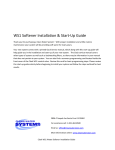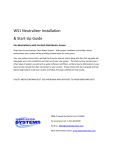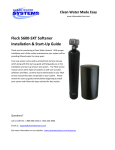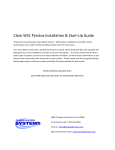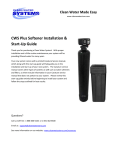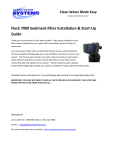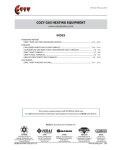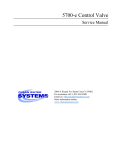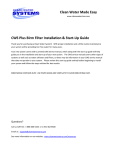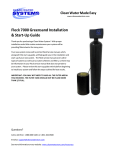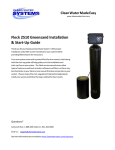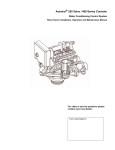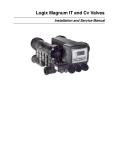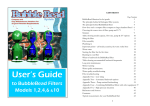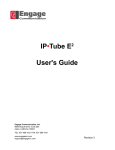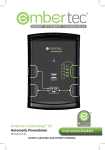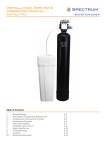Download WS1 Greensand Installation & Start-Up Guide
Transcript
WS1 Greensand Installation & Start‐Up Guide Thank you for purchasing a Clean Water System! With proper installation and a little routine maintenance your system will be providing filtered water for many years. Your new system comes with a printed Clack Service manual, which along with this start‐up guide will help guide you in the installation and start‐up of your new system. The Clack service manual covers other types of systems as well such as water softeners and filters, so there may be information in your manual that does not pertain to your system. Please review this start‐up guide entirely before beginning to install your system and follow the steps outlined for best results. 2806‐C Soquel Ave Santa Cruz CA 95062 For assistance call: 1‐831‐462‐8500 Email us: [email protected] More information online: www.cleanwaterstore.com Packing List by Model 1.0 Cubic Foot Quantity Description 1 WS1 Clack Backwash Control Valve 1 Pipe connector kit (either 1”or ¾”) 1 WS1 Bypass valve Filter tank, Distributor tube (in tank), media funnel 1 Potassium permanganate tank 1 12 lbs Gravel 2 ½ cubic foot boxes of Greensand‐Plus filter media 1 1.5 Cubic Foot Quantity Description 1 WS1 Clack Backwash Control Valve 1 Pipe connector kit (either 1”or ¾”) 1 WS1 Bypass valve Filter tank, Distributor tube (in tank), media funnel 1 Potassium permanganate tank 1 16 lbs Gravel 3 ½ cubic foot boxes of Greensand‐Plus filter media 2 2.5 Cubic Foot Quantity Description 1 WS1 Clack Backwash Control Valve 1 Pipe connector kit (either 1”or ¾”) 1 WS1 Bypass valve Filter tank, Distributor tube (in tank), media funnel 1 Potassium permanganate tank 1 20 lbs Gravel 5 ½ cubic foot boxes of Greensand‐Plus filter media 3 Page 2 Greensand WS1 Start‐Up Guide Clean Water Systems Rev 040110 Pre‐Installation 1. Review your packing list and make sure you have received all the parts before beginning installation. 2. If you are going to be turning off the water to the house and you have an electric water heater, shut off the power to the water heater before beginning installation in case water heater is accidentially drained. 3. Pick a suitable location for your filter system on a dry level spot where it won’t be exposed to freezing temperatures. A minimum of 20 PSI is required. Maximum pressure is 90 PSI. 4. Get all of your plumbing parts together before beginning installation. Installation typically takes 3 to 5 hours. However after installation the Greensand Filter must be allowed to run through a complete backwash and rinse cycle (also called ‘regeneration’). You don’t have to be present for this first backwash necessarily, but it does take 90 minutes. 5. After the system is installed and running, your water may be discolored, or full of sediment or rust, particularly if this is older piping that has been exposed to iron or manganese for some time. Typically this clears up over a day or two, but can persist for weeks if the pipe is old galvanized iron pipe that is corroded. Best Practices for Piping & Drain Installation 1. See typical installation (see Fig 1). The greensand filter is installed after the pressure tank. 2. Make sure to follow to connect the in pipe to the Clack WS1 inlet and the outlet to the outlet (see Fig 2). As you face the Clack WS1 control from the front, the water enters on the right and exits on the left. From the back (see Fig 2) the water enters on the left. The inlet and outlet are attached to the bypass valve which is marked with arrows as well. 3. Make sure there is a working gate or ball valve before the Clack WS1 Greensand filter and also one after as shown in the diagram. The pressure gauges are optional and not necessary but a hose bib (which is a faucet that you can attach a garden hose to) is strongly recommended after the Greensand Filter before the second ball valve. This makes it easy to rinse your new iron filter on start‐up and gives you a place to test the water before it enters your plumbing. 4. The Clack WS1 pipe fittings are either 1" threaded fittings, or ¾" slip (glue‐on) fittings. If you ordered the ¾" and are using stainless steel flex lines or other threaded pipe fittings to connect your piping to the ¾" Clack WS1 fittings, you will need to first glue on a PVC pipe fitting to the WS1 fitting and then attach the threaded stainless steel flex lines or your other threaded fittings you intend to use. 5. If you will be using copper piping, do not sweat the copper pipe directly on to the Clack WS1 control valve. Avoid heating up the control valve plastic. Page 3 Greensand WS1 Start‐Up Guide Clean Water Systems Rev 040110 6. You do not need unions to install your Clack WS1 control. If you need to remove it, the Clack WS1 has quick‐release couplings that make it easy to put the Greensand Filter on by‐pass and remove the filter system from the piping. 7. The drain line tubing (not supplied) is connected to a drain from the drain outlet using flexible ½” ID tubing. Note that the drain can run up above the Clack WS1 control and into a drain, it does not have to drain down, as the filter backwashes under line pressure from your well pump. Most plumbing codes require an air‐gap connection, so that if your sewer or septic tank backs up, it cannot cross connect with the drain tubing. Fig 1 ‐ Typical Greensand Clack WS1 piping installation: Page 4 Greensand WS1 Start‐Up Guide Clean Water Systems Rev 040110 Fig 2: Clack WS1 Greensand Iron Filter Installation Instructions 1. Unscrew by hand the entire Clack WS1 control valve from top of tank if it was shipped screwed on. Place distributor tube in tank if not already inside tank. If not already done, make sure blue cap is on top of distributor tube, or wrap the top of distributor tube with electrical or duct tape. The idea is we do not want gravel or media to go down the distributor tube when you are adding media. Page 5 Greensand WS1 Start‐Up Guide Clean Water Systems Rev 040110 Fig 3 Greensand diagram showing cut‐away of media and permanganate tank 2. Add filter gravel supplied first, using the funnel sent with the greensand filter. 3. Next add greensand media. Tank will be approximately 2/3 to the 3/4 full. 4. Remove cap or tape from top of distributor tube. Be careful not to pull up distributor tube when removing cap or tape. 5. If possible at this point, fill tank completely with water. This will allow the greensand media to settle and eliminate the need of “purging” the air out of the tank later. 6. Add a small amount of silicone grease or vegetable oil to the tank threads and screw on Clack WS1 control valve carefully. Do not use pipe‐joint compound, Teflon tape, or Vaseline or other petroleum greases to lubricate tank threads. Page 6 Greensand WS1 Start‐Up Guide Clean Water Systems Rev 040110 7. Now install your water pipes to the Clack WS1 bypass end connectors. Make sure inlet is installed to the 'In" pipe connector on the bypass valve and outlet is on the “Out” connector. Page 7 Greensand WS1 Start‐Up Guide Clean Water Systems Rev 040110 8. Connect some flexible tubing from the drain connection on the Clack WS1 control valve to a suitable drain such as a septic tank or drain to a sewer. It is OK to run the drain line up and over the Clack WS1 greensand filter up to 4 feet above the top of the tank. If the drain line will be more than 20 feet, use larger diameter tubing such as ¾” or 1”. Note that it is desirable to be able to run the drain line into a bucket in order to test the backwash flow rate in the future. This is why hard piping the drain line is discouraged, however, if you do use hard PVC piping for the drain line, and you are able to remove the hard PVC drain piping and attach flexible tubing should you ever desire for testing purposes, it is OK to use rigid PVC pipe for the drain. Make sure the drain tubing is firmly clamped to the barbed fitting with a hose clamp to prevent leaks. 9. Inside the potassium permanganate tank, remove the float assembly and remove the rubber band installed for shipping the tank, if present on the float assembly. Re‐install the float assembly. See Fig 4. Page 8 Greensand WS1 Start‐Up Guide Clean Water Systems Rev 040110 Fig 4 Potassium permanganate safety‐float assembly 10. Next attach the potassium permanganate solution tank tubing (3/8" black poly tubing) from the permanganate solution tank to the Clack WS1 control valve. Locate the 4’ length of plastic 3/8” tubing shipped inside the Pot Perm tank. As you stand in front of the Clack WS1 control, locate the male thread Pot Perm line tube connection fitting located on the top, left hand side of the valve body and attach the tubing, do not over‐tighten the nut. Attach the other end to the pot perm tank. Fig 5 and 6 Attaching the perm tubing to the perm solution tank Page 9 Greensand WS1 Start‐Up Guide Clean Water Systems Rev 040110 11. Add enough clean water to the pot perm solution tank to bring water level about 1” above the felt pad. Add one 5‐lb jug of potassium permanganate granules to the potassium perm tank by pouring it directly on top of the white felt pad. Do not pour permanganate down the white plastic brine well where the black line is attached. 12. See the over‐flow barbed fitting on the side of the perm tank. You do not have to connect to this to a drain. If the safety float were to malfunction, there is a small chance that pot perm solution will drip out of this fitting. If this would cause a big mess where you have installed the greensand filter, hook some tubing to this and run to a bucket, floor pan or floor drain. Normally no pot perm solution will leak out of this fitting. 13. Plug in your Clack WS1 control valve to an outlet. Your Clack WS1 control valve is already pre‐ programmed. All you need to do is to set the time of day, and then set the number of days the Neutralizer filter will run before it backwashes and regenerates automatically. 14. Set current time of day: Press NEXT button until of time of day is displayed. Press and hold the Up or Down button until the SET indicator is displayed and the hour flashes. Press the Up or Down button until the correct hour is displayed. Then press the NEXT button. The minutes will flash. Press the Up or Down button until the correct minute is displayed. Press the NEXT button to return to the Display Screens. 15. Press Next and Up button for five seconds and release. Adjust days to 4 to 7 days by using Up or Down buttons. If your water has over 7 to 10 ppm of iron in it set to every 1 or 2 days. Press NEXT. Use Up or Down button to change regeneration backwash time. Default is 2:00 am. If any water is used during the time the system is backwashing, the untreated water will flow into the house and the water will not be interrupted. Press NEXT to exit programming. 16. Turn the water back on but leave the greensand filter on bypass and check for leaks. Leave the ball valve after the greensand filter closed, so water is still off to the house, but connect a garden hose and open up the hose bib after the greensand filter and allow the water to run. This will help to clear out any foreign material that may be in the pipes from the piping installation. If you do not have a valve installed after the greensand filter and you do not have a hose bib, you will need to turn the water on inside the house to let the water run. Use a bathtub or laundry sink or other fixture that does not have an aerator screen. 17. Press the REGEN button for several seconds which will start the control valve into a regeneration cycle. You will hear the WS1 control valve motor start and move the control valve to the backwash position. 18. Now slowly turn the bypass valves to the service position which will allow water to flow to the iron filter and backwash the greensand filter. First open the Inlet Side of the bypass valve. Second slowly open the Outlet Side of the bypass until it is in full service position. Page 10 Greensand WS1 Start‐Up Guide Clean Water Systems Rev 040110 19. At this point the greensand filter will be in a backwash mode, which is the first of five cycles it goes through during regeneration. The backwash takes 10 minutes. After 10 minutes, the Clack WS1 will begin to suck up the permanganate solution from the permanganate tank. 20. After another 10 to 15 minutes the pot perm tank will be sucked dry of the liquid potassium permanganate. Check to make sure that the pot perm tank is empty after this cycle. 21. After 60 minutes of being in this Cycle 2, referred to as the brining cycle, it will move to the next cycle, Cycle 3, which is a 5 minute second backwash cycle. The next cycle, Cycle 4 is a 10 minute rapid rinse. Finally Cycle 5 refills the pot perm tank. 22. Check to make sure at the end of the cycles that the pot perm tank is filled with enough water to cover the felt pad by 1 or 2 inches. 23. After the regeneration process is complete, turn on the water to the house and run the water in the house for a few minutes. 24. Your water should have no iron or manganese or odors, and be clear in color. In some cases, if your pipes or water heater is full of iron or rust, you may experience discoloration from the pipes. 25. Refer to your Clack WS1 service manual for more information about how your control valve is programmed if desired. 26. Note – you should never see pink water in the household water after the iron filter. If pink water occurs after a regeneration, see Page 12 for steps on checking the cycles and cleaning the injector. Page 11 Greensand WS1 Start‐Up Guide Clean Water Systems Rev 040110 Maintaining Your Greensand WS1 Filter System Maintaining Your Greensand WS1 Filter System Maintenance is easy: just add one 5‐lb jug of potassium permanganate every 3 4 months. Check the potassium permanganate solution tank and when you see the mound of potassium permanganate disappear after a few months, just add another 5‐lb jug. Besides adding permanganate, it is important to clean the injector 1 to 3 times a year, depending on how much iron you have in your water. If your water is really high in iron, over 5 ppm, you may need to do it 3 times a year, otherwise once a year works well for most applications. Your greensand filter has 6 cycles or positions: 1st Cycle: Backwash (cleans the greensand media) 10 minutes 2nd Cycle: Regenerate (sucks in the potassium permanganate and restores the greensand) 60 minutes 3rd Cycle: Second Backwash (cleans the greensand media) 4 – 8 minutes 4th Cycle: Rinse (rinses the greensand media) 6 – 10 minutes 5th Cycle: Fill (re‐fills the potassium permanganate tank) 6 minutes 6th Cycle: Service (in the filtering position, ready for use) To change or verify these settings, see Page Cleaning the Injector Most problems that occur with the Greensand Filter systems that use potassium permanganate powder, involve the Injector Assembly. The Injector is the device that allows the permanganate solution to be sucked in during the backwash and regeneration cycle. If there is no permanganate solution sucked in during the regeneration, the greensand media will not be cleaned properly and will no longer remove iron, manganese or odors. Cleaning the injector is quick and easy and is part of the routine maintenance required to keep your greens and system working great. Page 12 Greensand WS1 Start‐Up Guide Clean Water Systems Rev 040110 Step 1: Put the Greensand filter on bypass by closing the inlet and outlet bypass valves; or turn the water pressure off to the filter. Step 2: Release the water pressure inside the Clack control valve. If you put the filter on bypass, you can do this by pressing the REGEN button. This will allow the control valve to enter a backwash cycle and since the water is turned off because the control valve is on bypass, it will release the pressure. If you shut off the water to the greensand filter by turning off a valve before the filter, you can release the pressure this way as well. Step 3: Unscrew the injector cap and lift off. Loosen cap with pliers if necessary. Page 13 Greensand WS1 Start‐Up Guide Clean Water Systems Rev 040110 Step 4: Remove the screen and clean if fouled. The injector can be pried out with a small flat screwdriver. The injector consists of a throat and a nozzle. Chemically clean theinjector with vinegar or sodium bisulfite (“RustOut or “RustRid” or ‘CLR” etc). The holes can be blown out with air. NOTE: Both pieces have small diameter holes that control the flow rates of water to insure that the proper concentration of regenerant is used. Sharp objects, which can score the plastic, should not be used to clea n the injector. Scoring the injector or increasing the diameter of the hole could change the operating para meters of the injector. Push the injector back firmly in place; replace the screen and hand tighten the injector cap. Step 5: Disconnect the black 3/8” poly tubing line that connects to the control valve from the perm tank. Step 6: Turn the water pressure back on slowly and check for leaks. A small amount of water may squirt o ut of the injector port, since you have removed the permanganate tubing. Step 7: With the greensand filter in the 2nd cycle, which is the Regenerate or injector‐draw cycle, it should be drawing or sucking in air and you can verify this by putting your thumb over the hole on the outside of control valve where the tube from the permanganate line is attached. If your greensand filter is not in the Regenerate cycle already, press the REGEN button. The first cycle is the Backwash cycle, which lasts for about 14 minutes. To skip ahead of this time and 1st cycle, you can press the REGEN button again, which will then advance the control valve to the brine draw, where the permanganate is sucked in, which is the 2nd cycle. Step 8: Press the REGEN button again and advance the control valve until it is in the 2nd Backwash cycle. At this point, you can re‐connect the poly tubing to the control valve. Step 9: After the control valve is back in its service position, then you can press the REGEN button and allo w it go to through a complete regeneration and backwash cycle. Pink Water NOTE: you should never see pink water after the greensand filter. Some causes are: 1. Low water pressure coming from the well. 2. Regeneration cycle was interrupted and the filter not allowed to backwash and rinse properly. 3. Injector needs to be cleaned, and/or injector screen is clogged. 4. Injector is worn out and needs to be replaced. 5. Backwash drain line is clogged, kinked or obstructed. 6. Backwash drain flow control is obstructed, and needs to be cleaned. To clean drain flow control remove the elbow locking clip holding it in, remove flow control fitting and blow out with air, or insert a paperclip to make sure it is free of debris. Page 14 Greensand WS1 Start‐Up Guide Clean Water Systems Rev 040110 If you see pink water after regeneration: 1. Check backwash flow rate to make sure it is adequate. To do this initiate a regeneration by pressing the REGEN button. The first cycle is the backwash. Allow the drain line to run into a 5 gallon bucket and time the filling of the bucket. A 1.0 and 1.5 greensand filter should have a backwash flow rate of 5 to 6 gallons per minute, meaning the bucket would fill in approximately 60 seconds. If you are using a 2.5 cu ft model, the backwash flow rate is 10 gallons per minute, so the bucket should fill in 30 seconds. After checking the backwash, put the filter on bypass to prevent it from sucking the permanganate during the next cycle. Press NEXT once to advance to the next cycle, when that is achieved, press NEXT again, and again, and allow it advance through the cycles until it returns to the time of day. Leave on by‐pass. 2. Check to make sure drain line is not kinked or obstructed. 3. Remove, inspect and clean the injector (see Page 12). 4. Check the regeneration cycles to make sure they are set correctly, and adjust the cycles for longer rinse cycles if needed: a. Step 1: Press NEXT and the Down button simultaneously for 5 seconds and release. b. Step 2: Select FILTERING if not already selected; Press NEXT c. Step 3: Adjust the length of backwash to 10 (for 10 minutes); Press NEXT d. Step 4: The regenerant draw should be set to 60 minutes. Change to 65 minutes to allow an extra 5 minutes of rinse for pink water conditions. Press NEXT e. Step 5: The 2nd Backwash cycle should be set to 6 minutes. For pink water conditions, change to 8 to 10 minutes. Press NEXT. f. Step 6: Adjust the length of rinse to 6 (for 6 minutes); For pink water conditions adjust to 10 minutes. Press NEXT g. Step 7: The Fill cycle should be set to 6 minutes. Press NEXT. Now the display will go back to the time of the day. 5. Check the potassium permanganate solution tank. The solution should be ½ to 1” above the felt pad that the permanganate powder is poured on top of. See Page 9. If necessary remove the float assembly and adjust the rubber washers holding the float assembly in place so the float is lower, and therefore shuts off the water sooner, which lowers the level of the permanganate. Page 15 Greensand WS1 Start‐Up Guide Clean Water Systems Rev 040110















